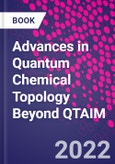Advances in Quantum Chemical Topology Beyond QTAIM provides a complete overview of the field, starting with traditional methods and then covering key steps to the latest state-of-the-art extensions of QTAIM. The book supports researchers by compiling and reviewing key methods, comparing different algorithms, and providing computational results to show the efficacy of the approaches. Beginning with an introduction to quantum chemistry, QTAIM and key extensions, the book goes on to discuss interacting quantum atoms and related energy properties, explores partitioning methods, and compares algorithms for QTAIM. Partitioning schemes are them compared in more detail before applications are explored and future developments discussed.
Drawing together the knowledge of key authorities in the area, this book provides a comprehensive, pedogeological guide to this insightful theory for all those interested in modelling, exploring and understanding molecular properties.
Please Note: This is an On Demand product, delivery may take up to 11 working days after payment has been received.
Table of Contents
1. Introduction to QTAIM and beyond
Fernando Cort�s-Guzm�n, Juan I. Rodr�guez, and�James S. M. Anderson
2. An Introduction to Quantum Chemistry
David C. Thompson and Juan I. Rodr�guez
3. New high performance QTAIM algorithms: From organic photovoltaics to catalyst materials
Juan I. Rodr�guez, H�ctor Daniel Morales-Rodr�guez, Emiliano Dorantes-Hern�ndez and Omar A. Alvarez-Gonzaga
4. Structural and Bond Evolutions During a Chemical Reaction
Pablo Carpio-Mart�nez and Fernando Cort�s-Guzm�n
5. The MC-QTAIM: A framework for extending the "atoms in molecules" analysis beyond purely electronic systems
Shant Shahbazian
6. Theory Developments and Applications of Next Generation QTAIM (NG-QTAIM)
Xing Nie, Yong Yang, Tianlv Xu, Steven R. Kirk, and Samantha Jenkins
7. Real-Space Description of Molecular Processes in Electronic Excited States
Jes�s Jara-Cort�s and Jes�s Hern�ndez-Trujillo
8. Open Quantum Systems, Electron Distribution Functions, Fragment Natural Orbitals and the Quantum Theory of Atoms in Molecules
Evelio Francisco, Aurora Costales and Angel Martin Pendas
9. The Ehrenfest Force
Yoshio Barrera, Airi Kawasaki, Paul W. Ayers and James S. M. Anderson
10. Relativistic QTAIM
James S. M.�Anderson
11. Chemical insights from the Source Function reconstruction of various scalar fields relevant to Chemistry�
Carlo Gatti and Giovanna Bruno
12. Scalar and vector fields derived from magnetically induced current density
Jos� E. Barquera-Lozada
13. Gradient Bundles
Amanda Morgenstern
14. Nonnuclear Maxima in the Molecular Electron Density
James S. M. Anderson, Aldo de Jesus Mortera-Carbonell and Ch�rif�F. Matta
15. Spin Polarization of the Atomic Valence Shell in Metal Complexes.
David I. Ram�rez-Palma, Ricardo Almada-Monter, Eduardo Orozco-Valdespino, Rosa Mar�a G�mez-Espinosa and Fernando Cort�s-Guzm�n
16. A Bond Bundle Case Study of Diels-Alder Catalysis and Selectivity Using Oriented Electric Fields
Timothy R. Wilson and M. E. Eberhart
17. Applications of the Quantum Theory of Atoms in Molecules and the Interacting Quantum Atoms Methods to the Study of Hydrogen Bonds
Jos� Manuel Guevara-Vela, Alberto Fern�ndez-Alarc�n and Tom�s Rocha-Rinza
18. Recent advances on halogen bonds within the quantum theory of atoms in molecules
Vincent Tognetti and Laurent Joubert
19. The Non-Covalent Interactions index: from biology to chemical reactivity and solid-state
Bruno Landeros-Rivera and Julia Contreras-Garc�a
20. Photochemistry: a topological perspective
Ismael Vargas-Rodriguez and Marco Garc�a-Revilla








